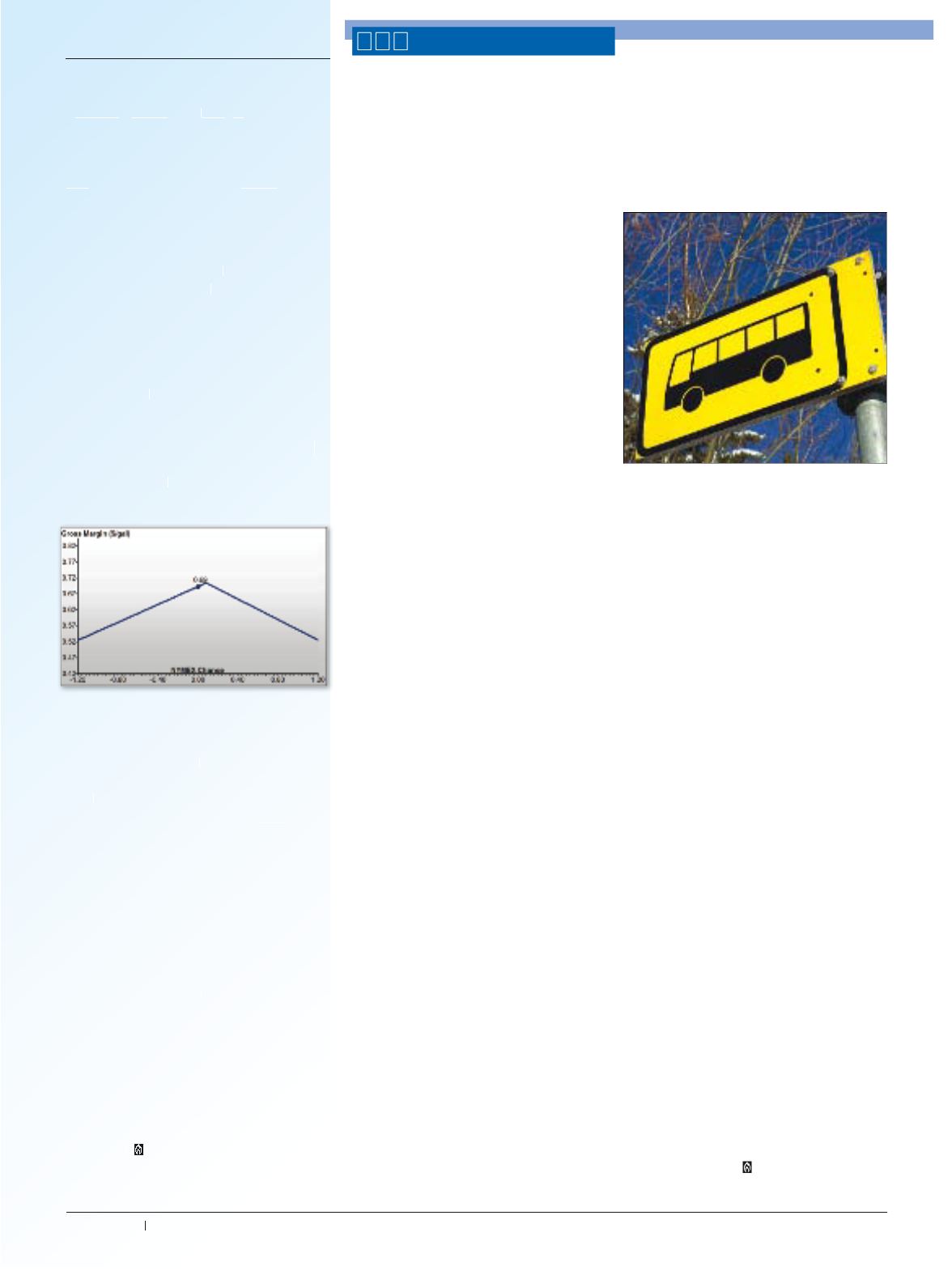
?<;>@E> 8>8@EJK ;<=8LC
KJ1 G8IK@8CCP
LE?<;><; =@O<; GI@:
< J8C<J
If the retailer d
oesn’t want to bear
the cost of 20
out call options, he c
an
still hedge
(sort of) against fixed
price
defaults. C
onsider for a moment
that the
most f
undamental upside pro
tection is
a fixe
d price hedge and t
he most funda-
me
ntal downside protect
ion is no hedge.
It’s going to be cru
de and imprecise, but
a combination of
these two approaches
is another way
to hedge against defaults.
The follow
ing illustrates this hedging
concept:
The heating oil retailer sells 200,000
fix
ed price gallons to consumers,
hedges these sales with 168,000 wet
barrel contract gallons purchased from
a supplier, leaves the remaining 32,00
0
gallons of fixed price sales unhe
dged
and experiences 30 percent d
efaul
ts.
Modeling shows the followin
g pro
gram
profitability profile:
At the curre
nt price, margin is 69
cents. If price
goes up $1.20 or down
$1.20, margi
n is 53 cents. That’s a
16
cent varia
tion, which is not very
good,
but on
the downside, it’s a l
ot better
than
the graph above (200K
fixed price
he
dges, no default hedge
s, 60K [30 per-
cent] defaults) where i
f price falls $1.20,
the margin is 32 cen
ts.
JLDD8IP
In sum
mary, here are the alternatives
for add
ressing the possibility of fixed
pric
e contract defaults, in order of p
refer-
e
nce: (1) Don’t sell fixed pri
ce gallons
(caps price only); (2) Colle
ct as much
fixed price money as pos
sible prior to
the start of the heating
season; (3) Hedge
potential fixed pric
e defaults with 20
cents out of the m
oney call options; and
(4) Leave som
e of the fixed price s
ales
unhedged
. How much unhedged?
Tha
t
can be
difficult to determine
withou
t
the b
enefit of a modeling t
ool, suc
h as
th
e proprietary softwar
e used b
y Hedge
Solutions.
>ÀiÌ -Ì>Vi
ÎÈÊU "
E
, 9
iiÌÊ >>}iiÌ
:fek`el\[ ]ifd gX^\ *+ ¿
EKJ9 ;\dXe[j 8l[`k f] =D:J8
Dispute could lead to tougher enforcement activities
By Matthew Wrobel, Foley Services
J:?8;<E=I<L;<% K?8KËJ EFK 8 KPGF Ç
it’s a (long) German word that means taking
pleasure at the misfortune of others. There
are going to be plenty of motor carriers
feeling that way this month, as the National
Transportation Safety Board has laid a
broadside at the Federal Motor Carrier
Safety Administration.
Citing a number of accidents that it has
investigated, the NTSB has raised ques-
tions about FMCSA’s ability to regulate the
industry and improve safety. The NTSB has
demanded that FMCSA undergo a full audit
by government officials.
While it would probably be difficult
to find any sympathy at carriers who have
undergone an FMCSA audit or Compliance
Review, motor carriers should be wary
about what that could mean. The results of
the audit are unlikely to improve the situa-
tion for carriers. Much more likely, it means
that enforcement and oversight is going to
get much worse.
EKJ9 :FDGC8@EKJ
Essentially, NTSB has said that FMCSA
is not doing enough to prevent accidents
involving motor carriers (FMCSA’s mission
statement). They have also raised concerns
that FMCSA’s new systems (CSA) are not
aggressive enough at going after carriers
with past violations.
“While FMCSA deserves recognition
for putting bad operators out of business,
they need to crack down before crashes
occur, not just after high visibility events,”
said NTSB Chairman Deborah A.P.
Hersman. “Our investigators found, that in
many cases, the poor performing company
was on FMCSA’s radar for violations but
was allowed to continue operating and
was not scrutinized closely until they had
deadly crashes.”
NTSB criticized the “quality and thor-
oughness” of FMCSA’s compliance reviews
and took a hard line against FMCSA per-
forming focused compliance reviews that
only look at one area of the regulations.
8::@;<EKJ
NTSB has come to this point after
investigating a number of accidents that it
believes FMCSA had the power to prevent.
In the four cases, FMCSA had either been
investigating the carrier for other reasons
and failed to note issues that contributed
to crash or they had deemed the carrier to
be safe. NTSB was disturbed by the fact that
these carriers, rated ‘satisfactory,’ could be
found non-compliant so quickly after the
accident.
The four accidents cited occurred in the
last 12 months, indicating that this is an
ongoing problem that has not been solved
by the shift to CSA-based compliance. The
four accidents include:
U *i`iÌ "Ài°] iV° Îä] Óä£Ó
U -> iÀ>À`] >v°] iL° Î] Óä£Î
U â>LiÌ
ÌÜ] Þ°] >ÀV
Ó] Óä£Î
U ÕÀvÀiiÃLÀ] /i°] Õi £Î] Óä£Î
N?8K ;F<J K?@J D<8E6
Unfortunately, this probably means that
we can expect an increase in enforcement
in the next few years. It continues a trend
from recent months that is forcing FMCSA
to behave much more aggressively towards
carriers. Other recent changes include a
Congressional directive that FMCSA can
no longer take a carrier’s ability to pay as a
factor when deciding to levy fines for non-
compliance.
If NTSB gets its way (and it usually does,
as the passenger car and airline industries
can tell you), FMCSA will have to increase
the depth and number of compliance
reviews. It will mean more inspections and
much less leeway if errors are found.
While many carriers would laugh at this
statement, FMCSA is actually comparatively
friendly towards the industry. Between the
recent developments in Congress and the
results of this audit, we could see a big shift
in that relationship toward one that is much
more antagonistic.


